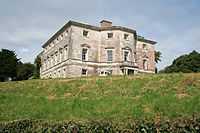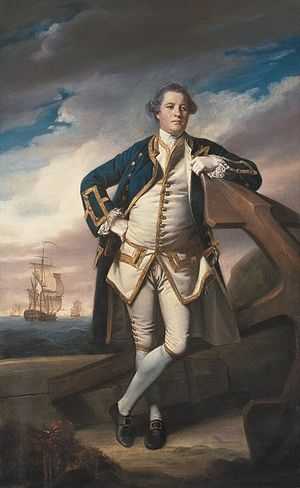Sharpham, Ashprington



Sharpham is an historic estate in the parish of Ashprington, Devon. The mansion house known as Sharpham House, overlooking the River Dart, is a Georgian Grade I listed building,[1] commenced in about 1770 by Captain Philemon Pownoll (d.1780), Royal Navy, to the designs of the architect Sir Robert Taylor (1714–1788). In the opinion of Nikolaus Pevsner it contains "one of the most spectacular and daring later 18th century staircase designs anywhere in England".[2]
Descent
In the 15th century it was owned by Robert French[3] of Horneford, whose daughter and heiress Amey (or Maude) French married (as his second wife) Sir John Prideaux (fl.1433) of Adeston[4] in the parish of Holbeton and of Orcharden (alias Orcharton) in the parish of Shilston, near Modbury, Devon. Her daughter and heiress was Joane Prideaux, who married firstly to William Drewe, secondly to Baldwin Acland of Acland, Landkey, Devon, ancestor of the Acland Baronets. Sharpham descended thenceforth in the Drewe family as follows:[5]
Drewe
- William Drewe (d.1548), 3rd son, of Kenn in Devon, who married a certain Elinor
- John Drewe, son, a lawyer of Grays Inn, who married Joane Cruwys a daughter of a member of the Cruwys family of Cruwys Morchard, Devon.
- John Drewe (d.1574), of St Leonard's, Devon, son and heir and heir to his grandfather. He married twice, firstly to Anne Yorke, daughter of Watkyn Yorke of Devon, secondly to a lady of the Bridges family.
- Thomas Drewe, son, of Sharpham and Killerton, Devon, who married Elinor Hackmore, daughter and co-heiress of William Hackmore.

- Edward Drewe (c.1542-1598), son, of Sharpham, a Serjeant-at-Law to Queen Elizabeth I, MP for Lyme Regis 1584, twice for Exeter in 1586 and 1589 and for the prestigious seat of the City of London in 1593.[8] He purchased the estate of The Grange in Broadhembury,[9] the former grange of Dunkeswell Abbey,[10] where he built himself a new mansion house and where he entertained Queen Elizabeth I, who subsequently sent him her portrait,[11] attributed to George Gower (c.1540–1596),[12] long kept at The Grange,[13] since 2005 owned by Chris Nightingale of Appleby Castle, Cumbria Historical Portraits Ltd.[14] He moved his residence to The Grange and sold Sharpham to John Giles of Bowden, an adjacent estate.[15] Edward Drewe married Bridget FitzWilliam of Mablethorpe, Lincolnshire, by whom he had a son and heir Sir Thomas Drewe (d.1651) of The Grange, Sheriff of Devon in 1612, who sold Killerton to Sir Arthur Acland (d.1610) of Acland, Landkey.[16]
Giles
- John Giles (d.1606) of Bowden, an adjacent estate in Ashprington, who purchased Sharpham from Edward Drewe.[17] He was the eldest son of William Giles of Bowden by his wife Joane Blackall (alias Blackaller) of Totnes.[18] He married Agnes Stucley, a daughter of Sir Hugh Stucley (1496-1559) of Affeton, Devon, Sheriff of Devon in 1545.[19]
- Sir Edward Giles (1566-1637), Knight, eldest son and heir, of Bowden, who at the time of the writing of the Survey of Devon by Tristram Risdon (d.1640), was the owner of Sharpham. He married Mary Drew (d.1642/3), daughter and heiress of Edmond Drew of Hayne, Newton St Cyres, Devon (who bore the same arms as Drew of Sharpham but whose kinship to that family is not clear), widow of Walter Northcote. He died without progeny.[20]
Yarde
The Giles family sold Sharpham to the Yarde family of Bradley in the parish of Kingsteignton.
- Gilbert Yard (1672/3-1707), of Sharpham, was MP for Ashburton 1705-7. He was buried at Ashprington. He was the eldest son of Gilbert Yarde (d.1692) of Bradley by his wife Elizabeth Northleigh, daughter of Henry I Northleigh of Peamore, Exminster and sister of Henry II Northleigh (1643-1694) of Peamore, thrice MP for Okehampton.[21] In 1694/5 he married Joane Blackaller (d.1725), daughter of Henry Blackaller "of Sharpham".[22]
- Gilbert Yarde (born 1698), son and heir, of Sharpham, living in 1725.
Cockey
In 1748 Sharpham was sold by Gilbert Yard to Philip Cockey,[23] who was seemingly more interested in the resale value of the timber in the park than in the house.[24] The sale particulars described the estate as having extensive woodlands, a mansion house and several walled gardens. These are visible on a survey of 1749. A marriage contract for the sum of £200 dated 1749 survives in Plymouth and West Devon Record Office[25] listing as parties: 1: William Cockey of Totnes, brazier; 2: Elizabeth Hannaford of Totnes, spinster; 3: Philip Cockey of Sharpham, gentleman and Benjamin Blackaller of Totnes, mercer. Another document dated 1763 survives in Cornwall Record Office[26] summarised as follows: Parties: (1) William Shepherd and John Bayly both of Plymouth, merchants, to (2) Philip Cockey of Sharpham, Devon, esquire, Richard Dunning of Plymouth, gentleman, Peter Baron of Stoke Damerel, gentleman and Robert Baron of Plymouth, brazier. Bond in £500 To indemnify (2) against cost of lawsuits concerning Presbyterian church in Plymouth. In 1765 Philip Cockey sold Sharpham to Captain Philemon Pownoll, having previously in 1755 offered a lease on the estate.
Pownoll

Mr Cockey sold it in about 1763 to Captain Philemon Pownoll (c.1734-1780) of the Royal Navy, born in Plymouth and the son of master shipwright Israel Pownoll (d.1779), master shipwright of Plymouth Dockyard (1762-5) and of Chatham (1775-9), who had built a large number of warships for the Royal Navy. In 1762 Philemon Pownoll had acquired a fortune of £64,963 having captured a Spanish Galleon,[27] and in about 1770 commenced the building of the present house, completed after his death by his daughter and heiress Jane Pownall (d.1822).
Bastard
.svg.png)
- Edmund Bastard (1758-1816), of Kitley, Yealmpton, MP for Dartmouth,[28] who married Jane Pownall (d.1822), the heiress of Sharpham.
- Captain John Bastard (1737-1835), Royal Navy, second son, MP for Dartmouth. While Jane's eldest son Edmund Pollexfen Bastard (1784-1838), MP for Devon, inherited Kitley, her second son inherited Sharpham.[29] He is said to have lost his fortune in gambling.[30]
Durant
Richard Durant purchased Sharpham in 1841, and it remained in the ownership of his descendants until 1940, when the estate was split up and sold, with Avenue Cottage sold separately.[31]
Ash
In 1962 Sharpham House was purchased by Maurice Ash (1917-2003), whose property developer grandfather, Gilbert Ash, had left him a large fortune. He was an environmentalist, writer, and planner. He was chairman of the Town and Country Planning Association and of the Dartington Trust. After World War II his friend Michael Young, later Lord Young of Dartington, introduced him to the Dartington Hall Trust, a design school with craft workshops, established by Leonard Elmhirst and his wealthy American heiress wife Dorothy Whitney, who in the 1920's had purchased the historic estate of Dartington Hall near Totnes and had restored at great expense the manor house and its mediaeval Great Hall. In 1947 Maurice Ash married Ruth Elmhirst, Leonard and Dorothy's daughter. Maurice and Ruth laid out formal gardens at Sharpham to the design of Percy Crane.[32] In 1982 the Sharpham estate was transferred by Mr Ash to a charitable trust known as the Sharpham Trust, and he continued to reside at Sharpham until his death in 2003.[33]
Sharpham Trust
In 1982 Sharpham House was acquired by the Sharpham Trust,[34] still the owner in 2015, an educational charity "whose aims and objectives are to maintain, conserve and enhance the land, buildings, resources and biodiversity of the estate for public benefit; to provide opportunities for physical intellectual emotional and spiritual learning through activity, reflection, creativity and enquiry offering meditative and spiritual retreats in the house and grounds".[35] Sharpham Vineyard is situated within the estate.
References
- ↑ Listed building text
- ↑ Pevsner, Nikolaus & Cherry, Bridget, The Buildings of England: Devon, London, 2004, pp.722-3
- ↑ Risdon, Tristram (d.1640), Survey of Devon, 1811 edition, London, 1811, with 1810 Additions, p.167
- ↑ Vivian, pp. 306, 618
- ↑ Vivian, p.306
- ↑ Vivian, Lt.Col. J.L., (Ed.) The Visitation of the County of Devon: Comprising the Heralds' Visitations of 1531, 1564 & 1620, Exeter, 1895, p.306
- ↑ Philip Mould Ltd, 29 Dover Street, London
- ↑ History of Parliament biography
- ↑ Risdon, pp.43-4
- ↑ Pevsner, p.217
- ↑ Vivian, p.306, but incorrectly regarding his father Thomas Drew
- ↑ Philip Mould Ltd, 29 Dover Street, London
- ↑ Vivian, p.306
- ↑ Philip Mould Ltd
- ↑ Risdon, p.167; Gray, Todd & Rowe, Margery (Eds.), Travels in Georgian Devon: The Illustrated Journals of The Reverend John Swete, 1789-1800, 4 vols., Tiverton, 1999, Vol.4, p.103
- ↑ Vivian, p.307; Acland, Anne, A Devon Family: The Story of the Aclands. London and Chichester: Phillimore, 1981, pp.4-6
- ↑ Risdon, p.167; Gray, Todd & Rowe, Margery (Eds.), Travels in Georgian Devon: The Illustrated Journals of The Reverend John Swete, 1789-1800, 4 vols., Tiverton, 1999, Vol.4, p.103
- ↑ Vivian, p.409, pedigree of Giles
- ↑ Vivian, p.721, pedigree of Stucley
- ↑ Vivian, p.409, pedigree of Giles
- ↑ Vivian, p.832, pedigree of Yarde; p.584, pedigree of Northleigh
- ↑ Vivian, p.832, pedigree of Yarde
- ↑ National Heritage List of Historic Buildings and Ancient Monuments ; Risdon, 1810 Additions, pp.380-1
- ↑ Listed building text
- ↑ Plymouth and West Devon Record Office, reference: 242/8/411
- ↑ Cornwall Record Office, RD/1379
- ↑ Pevsner, p.722
- ↑ Risdon, 1810 Additions, pp.380-1; Vivian, p.51, pedigree of Bastard
- ↑ Vivian, p.51, pedigree of Bastard
- ↑ National Heritage List of Historic Buildings and Ancient Monuments, quoting "Debois Landscape Survey Group 1993"
- ↑ National Heritage List of Historic Buildings and Ancient Monuments
- ↑ National Heritage List of Historic Buildings and Ancient Monuments
- ↑ See
- ↑ National Heritage List of Historic Buildings and Ancient Monuments
- ↑ Sharpham Trust website